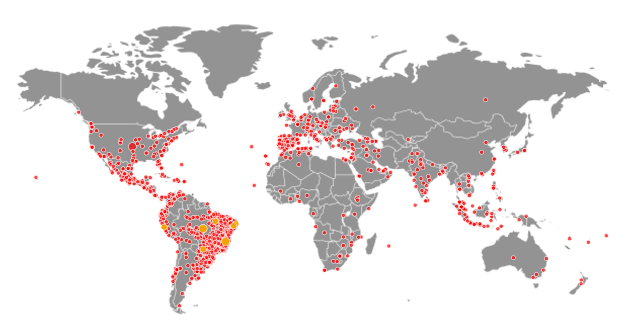DETERMINATION OF FREE ACIDITY IN SULFURIC LIQUORS USING THE OXALATE METHOD: SCOPE, LIMITATIONS, AND VALIDATION
DOI:
https://doi.org/10.61164/1knf6e79Palavras-chave:
Free acidity. Oxalate titration. Ferric iron. Sulfuric liquors. Hydrometallurgy. Analytical method validationResumo
The Oxalate Method is a classical procedure for determining free acidity in complex sulfuric liquors from hydrometallurgical processes. By selectively complexing hydrolysable cations such as Fe³⁺, Al³⁺, and Mg²⁺ through the addition of potassium oxalate, the method reduces interference from metal hydrolysis. This revised study incorporates reviewer feedback, including discussion of chemical mechanisms, industrial applications, and the effects of interfering ions. The method demonstrated robust performance up to 40 g/L of Fe³⁺ and across a wide acidity range, making it suitable for routine monitoring of leaching solutions containing elevated levels of base metals. Additionally, an adaptation for low-acidity samples is proposed, improving their analytical applicability in diluted matrices.
Downloads
Referências
[1] D.C. Harris, Quantitative chemical analysis, 6th ed., New York: W.H. Freeman, 2003. 744 p. ISBN: 9780716744641..
[2] F.N. Jackson, E. Silva, P. Oliveira, Determinação de acidez livre pelo método da complexação dos cátions hidrolisáveis, CETEM, Rio de Janeiro, 1981. Available at: //efaidnbmnnnibpcajpcglclefindmkaj/https://mineralis.cetem.gov.br/bitstream/cetem/218/1/stm-19.pdf? Accessed on: September 03 2025.
[3] T. Michałowski, A. Baterowicz, A.Madej, J. Kochana. Extended Gran method and its applicability for simultaneous determination of Fe(II) and Fe(III). Anal Chim Acta. 2001;442(2):287-93. doi:10.1016/S0003-2670(01)01172-2.
[4] T. Michałowski, M. Lisoń, Overview on the Gran and other linearisation methods, Talanta 64 (2004) 29–41. https://doi.org/10.1016/j.talanta.2004.04.038.
[5] [5] M. Rigobello-Masini, J.C. Masini, Application of modified Gran functions and derivative methods to potentiometric acid titration studies of the distribution of inorganic carbon species in cultivation medium of marine microalgae, Anal. Chim. Acta. 448(1–2) (2001) 239–250. https://doi.org/10.1016/S0003-2670(01)01312-5.
[6] M. Mayer, Identification of a two-coordinate iron(I)–oxalate complex, Angew. Chem. Int. Ed. 61 (2022). https://doi.org/10.1002/anie.202117855.
[7] M. Mollar, I. Castro, F. Lloret, et al., Solution study of complex formation between iron(III) and oxalate in dimethyl sulfoxide, Transit. Met. Chem. 16 (1991) 31–34. https://doi.org/10.1007/BF01127866.
[8] F. Capitan, A. Arrebola Ramirez, C. Jimenez Linares, Spectrophotometric determination of trace amounts of iron(III) in oxalates by extraction of the mixed ligand iron oxalate purpurin complex, Analyst 110 (1985) 819–821. https://doi.org/10.1039/AN9851000819.
[9] Y. Liu, C. Zhang, B. Li, H. Li, H. Zhan, Extraction and determination of total and soluble oxalate in pulping and papermaking raw materials, BioResources 10 (2015) 4580–4595. https://doi.org/10.15376/biores.10.3.4580-4595.
[10] D.A.Skoog. Fundamentals of analytical chemistry. 8th ed. Belmont: Thomson-Brooks/Cole; 2004. 1051 p. (International student edition; Saunders golden sunburst series). ISBN: 9780534417970.
[11] A.I. Vogel, Vogel's textbook of quantitative chemical analysis. 5th ed. Harlow: Longman Scientific & Technical; 1989. 1210 p.
[12] D. Harvey, Modern analytical chemistry, Boston: McGraw-Hill, 2000. 798 p. ISBN: 0072375477.
[13] G.D. Christian, Analytical chemistry, 6th ed., New Delhi: Wiley India Pvt. Limited, 2007. 856 p. ISBN: 9788126511136.
[14] G. Schwarzenbach, H.A. Flaschka, Complexometric titrations, 2nd ed., London: Methuen, 1969. 490 p. ISBN: 9780416192902.
[15] Z. Ahmed, G.M. Adly, M.A. Farag, Management strategies for the antinutrient oxalic acid in foods: a comprehensive overview, Food Bioproc. Technol. 18 (2025) 4280–4300. https://doi.org/10.1007/s11947-024-03726-0.
Downloads
Publicado
Edição
Seção
Licença
Copyright (c) 2025 Revista Multidisciplinar do Nordeste Mineiro

Este trabalho está licenciado sob uma licença Creative Commons Attribution-NonCommercial-ShareAlike 4.0 International License.
Autores que publicam nesta revista concordam com os seguintes termos:
- Autores mantém os direitos autorais e concedem à revista o direito de primeira publicação, com o trabalho simultaneamente licenciado sob a Licença Creative Commons Attribution que permite o compartilhamento do trabalho com reconhecimento da autoria e publicação inicial nesta revista;
- Autores têm autorização para assumir contratos adicionais separadamente, para distribuição não-exclusiva da versão do trabalho publicada nesta revista (ex.: publicar em repositório institucional ou como capítulo de livro), com reconhecimento de autoria e publicação inicial nesta revista, desde que adpatado ao template do repositório em questão;
- Autores têm permissão e são estimulados a publicar e distribuir seu trabalho online (ex.: em repositórios institucionais ou na sua página pessoal) a qualquer ponto antes ou durante o processo editorial, já que isso pode gerar alterações produtivas, bem como aumentar o impacto e a citação do trabalho publicado (Veja O Efeito do Acesso Livre).
- Os autores são responsáveis por inserir corretamente seus dados, incluindo nome, palavras-chave, resumos e demais informações, definindo assim a forma como desejam ser citados. Dessa forma, o corpo editorial da revista não se responsabiliza por eventuais erros ou inconsistências nesses registros.
POLÍTICA DE PRIVACIDADE
Os nomes e endereços informados nesta revista serão usados exclusivamente para os serviços prestados por esta publicação, não sendo disponibilizados para outras finalidades ou a terceiros.
Obs: todo o conteúdo do trabalho é de responsabilidade do autor e orientador.







